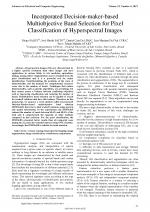| 4/2019 - 3 |
Incorporated Decision-maker-based Multiobjective Band Selection for Pixel Classification of Hyperspectral ImagesSAQUI, D. |
| Extra paper information in |
| Click to see author's profile in |
| Download PDF |
Author keywords
remote sensing, hyperspectral imaging, image segmentation, image classification, evolutionary computation
References keywords
hyperspectral(26), remote(21), selection(20), sensing(17), band(14), classification(12), geoscience(10), image(8), feature(7), tgrs(6)
Blue keywords are present in both the references section and the paper title.
About this article
Date of Publication: 2019-11-30
Volume 19, Issue 4, Year 2019, On page(s): 21 - 28
ISSN: 1582-7445, e-ISSN: 1844-7600
Digital Object Identifier: 10.4316/AECE.2019.04003
Web of Science Accession Number: 000500274700003
SCOPUS ID: 85077276122
Abstract
Hyperspectral images (HIs) are characterized by a higher spectral resolution than other images and have applications in various fields, to wit, medicine, agriculture, mining, among others. Segmentation can be obtained from the pixel classification and it is a powerful tool for object identification. Notwithstanding, the problems of the curse of dimensionality and the demand for computational resources occur due to the number of bands. Techniques that reduce dimensionality, such as genetic algorithms, are promising, but they cannot assure a balance between conflicting objectives such as improving classification and reducing the number of bands. Multiobjective band selection can be applied to search for tradeoff solutions that have this balance. Therefore, in this manuscript, we propose a novel method called Incorporated Decision-Marker-based multiobjective band selection (IDMMoBS) that tries to find tradeoff solutions using spectral and spatial information. In the experiments, the IDMMoBS reduced the number of bands between 85.4 and 85.8 percent of the total and it outperformed the majority of other methods compared in this criterion. For the pixel classification, the IDMMoBS presented better results than all compared cases taking into account all evaluated metrics using SVM classifier. Accordingly, the IDMMoBS is suitable for band selection. |
| References | | | Cited By |
Web of Science® Times Cited: 2 [View]
View record in Web of Science® [View]
View Related Records® [View]
Updated 2 weeks, 3 days ago
SCOPUS® Times Cited: 2
View record in SCOPUS® [Free preview]
View citations in SCOPUS® [Free preview]
[1] An ant interaction scheme based wrapper strategy for hyperspectral band selection, Deep, Kamal, Verma, Bhisham Dev, Thakur, Manoj, Infrared Physics & Technology, ISSN 1350-4495, Issue , 2025.
Digital Object Identifier: 10.1016/j.infrared.2025.105726 [CrossRef]
[2] Multiobjective Optimization-Based Hyperspectral Band Selection for Target Detection, Song, Meiping, Liu, Shihui, Xu, Dayong, Yu, Haoyang, IEEE Transactions on Geoscience and Remote Sensing, ISSN 0196-2892, Issue , 2022.
Digital Object Identifier: 10.1109/TGRS.2022.3176856 [CrossRef]
Disclaimer: All information displayed above was retrieved by using remote connections to respective databases. For the best user experience, we update all data by using background processes, and use caches in order to reduce the load on the servers we retrieve the information from. As we have no control on the availability of the database servers and sometimes the Internet connectivity may be affected, we do not guarantee the information is correct or complete. For the most accurate data, please always consult the database sites directly. Some external links require authentication or an institutional subscription.
Web of Science® is a registered trademark of Clarivate Analytics, Scopus® is a registered trademark of Elsevier B.V., other product names, company names, brand names, trademarks and logos are the property of their respective owners.
Faculty of Electrical Engineering and Computer Science
Stefan cel Mare University of Suceava, Romania
All rights reserved: Advances in Electrical and Computer Engineering is a registered trademark of the Stefan cel Mare University of Suceava. No part of this publication may be reproduced, stored in a retrieval system, photocopied, recorded or archived, without the written permission from the Editor. When authors submit their papers for publication, they agree that the copyright for their article be transferred to the Faculty of Electrical Engineering and Computer Science, Stefan cel Mare University of Suceava, Romania, if and only if the articles are accepted for publication. The copyright covers the exclusive rights to reproduce and distribute the article, including reprints and translations.
Permission for other use: The copyright owner's consent does not extend to copying for general distribution, for promotion, for creating new works, or for resale. Specific written permission must be obtained from the Editor for such copying. Direct linking to files hosted on this website is strictly prohibited.
Disclaimer: Whilst every effort is made by the publishers and editorial board to see that no inaccurate or misleading data, opinions or statements appear in this journal, they wish to make it clear that all information and opinions formulated in the articles, as well as linguistic accuracy, are the sole responsibility of the author.



